One Year of Ambassador’s Life Spent in Belgium (No.33)
One year has passed since my arrival in Belgium. Looking back, I feel it was short. Due to lack of time, I feel as if I was not able to do even half of what I wanted to do. The basis of my diplomatic activities is the “on-the-spot principle”, giving priority to the following three points: minimizing desk work, going out to expand my circle of friends and acquaintances and to visit the provinces, observing activities of educational institutions and companies. In addition, public relations are also an important task of the Ambassador, so I value the opportunity to have media interviews or to give conferences and lectures in front of a large number of people. I took advantage of various events and lunch or dinner occasions to become acquainted with many Belgian politicians and people from the business world. Belgians, generally, have an open mind, so they associate with us foreigners without reserve. Also, as Belgium is a small country, I am glad that I can go anywhere in the country by one or a one and a half hour’s drive without having to use an airplane to visit the regions. Therefore I was able to visit most of the major regional cities in the past year. Belgium can be proud of its world-class church architecture and castles and its abundant nature. The food is delicious as well. Having a beer with pomme frite (French fries) is a fun pastime for many Japanese residing in Belgium. My first year went by in the blink of an eye and I am currently pondering how to spend coming days of the second year in a meaningful way.
< The Second European Ambassadors’ Meeting of This Year in Tokyo >
According to diplomatic practice in Japan, once a year, an Ambassadors’ meeting per area is held in Tokyo, but following the European Ambassador’s Meeting in February, a second one was held this year. However, according to the Japanese fiscal year (April to March), the meeting last February was held in the previous year. Therefore, it is still once a year. In short, the timing was just earlier than in the previous years. During the meeting of two days and a half, presentations and debate sessions were held about various themes between the executives of the Ministry of Foreign Affairs and the Ambassadors. In addition to the meeting with Prime Minister Abe and Foreign Minister Kishida, discussions with the Liberal Democratic Party's Foreign Affairs Division and Keidanren (Federation of Economic Organizations) took place as well. Also, we had the opportunity to hear the opinions from academic experts about Abenomics and a media training preparing the ambassadors for interviews with the foreign press was provided. Though it was a productive Ambassador’s Meeting, the commute was very hard because of the typhoon hitting Tokyo in those days. I got on a train so packed with people it could be a Guiness Record and I realized the hardship of working in Tokyo.
< Two Japanese Companies >
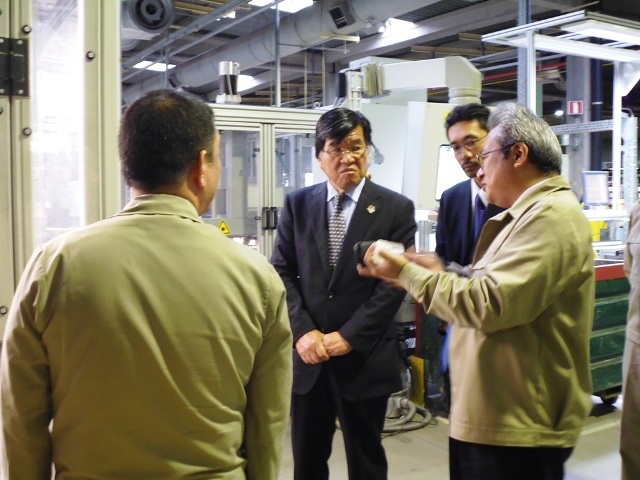 About ten days earlier, I visited NGK CERAMICS EUROPE in Saint Ghislain (located 70 km southwest of Brussels). This company, founded in 1985, is a subsidiary of “NGK Insulators, LTD”, headquartered in Nagoya city in Japan. NGK Insulators, LTD has 17 production bases in 10 countries overseas and the factory in Saint Ghislain was the first overseas production base. They manufacture a “catalytic converter unit” called “Honeyceram” to purify automotive exhaust fumes and this unit is sold to companies that are producing catalysts. In the next step, the unit is attached inside in the middle of the expanded part of the exhaust pipe. Finally, it is delivered to the car manufacturing companies as an exhaust pipe. The ceramic product “honeyceram” looks like cylindrical toilet paper roll, but has countless tiny holes (more than 10.000?) at the cross section like a beehive. When coating the catalyst to the wall surfaces of these holes (0.05 mm thick), a chemical reaction occurs when exhaust gas passes through and detoxifies the harmful gas. In the case of the toilet paper roll sized “honeyceram”, the wall surface of the holes is surprisingly as large as two soccer grounds. There are 263 regular employees, including 7 Japanese. Mechanization is quite advanced due to the high labour cost in Belgium. About ten days earlier, I visited NGK CERAMICS EUROPE in Saint Ghislain (located 70 km southwest of Brussels). This company, founded in 1985, is a subsidiary of “NGK Insulators, LTD”, headquartered in Nagoya city in Japan. NGK Insulators, LTD has 17 production bases in 10 countries overseas and the factory in Saint Ghislain was the first overseas production base. They manufacture a “catalytic converter unit” called “Honeyceram” to purify automotive exhaust fumes and this unit is sold to companies that are producing catalysts. In the next step, the unit is attached inside in the middle of the expanded part of the exhaust pipe. Finally, it is delivered to the car manufacturing companies as an exhaust pipe. The ceramic product “honeyceram” looks like cylindrical toilet paper roll, but has countless tiny holes (more than 10.000?) at the cross section like a beehive. When coating the catalyst to the wall surfaces of these holes (0.05 mm thick), a chemical reaction occurs when exhaust gas passes through and detoxifies the harmful gas. In the case of the toilet paper roll sized “honeyceram”, the wall surface of the holes is surprisingly as large as two soccer grounds. There are 263 regular employees, including 7 Japanese. Mechanization is quite advanced due to the high labour cost in Belgium.
Also, the other day, I was invited to a ceremony to commemorate the 35th anniversary of the opening of the Ghent factory of Honda Motor Co., Ltd (See Ambassador’s Chat No. 5). Honda Motor Co. Ltd started its activities in Belgium in 1962 in Aalst, located between Ghent and Brussels. The Ghent factory was established 16 years later and has become now a European hub for distribution of small spare parts. At the ceremony, the humanoid robot Asimo, developed by Honda, gave an outstanding performance. Innovative technologies advance in Asimo, who can walk as fast as 9 km per hour, who can walk on a slope and who can unscrew the cap of a PET bottle and pour it out. The development of a humanoid robot by an automobile company is an interesting idea.
< Two Mini Concerts Held at the Ambassador’s Residence >
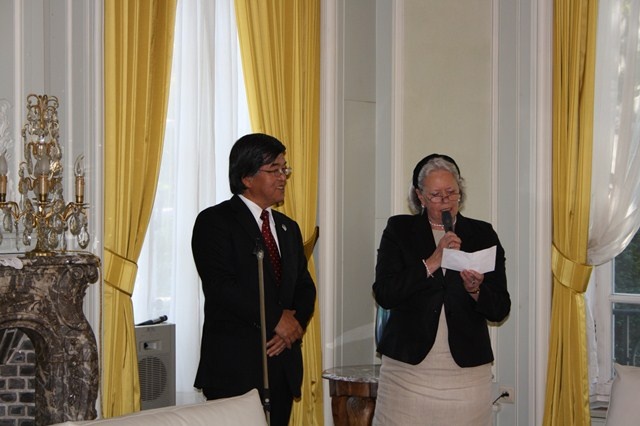
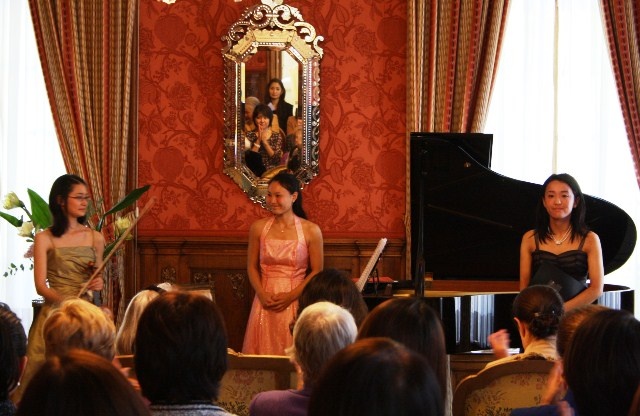 Recently two mini classical music concerts in a row were held at the Ambassador’s residence to the great pleasure of the guests. On the first occasion, the Belgian women who are members of the pro-Japanese association called “Thé de l’Amitié” were invited to the performance of 3 Japanese female students who are studying at the music school in Brussels. The combination of violin, piano and singing created an atmosphere like a home concert where the distance between performers and the audience is close. Recently two mini classical music concerts in a row were held at the Ambassador’s residence to the great pleasure of the guests. On the first occasion, the Belgian women who are members of the pro-Japanese association called “Thé de l’Amitié” were invited to the performance of 3 Japanese female students who are studying at the music school in Brussels. The combination of violin, piano and singing created an atmosphere like a home concert where the distance between performers and the audience is close.
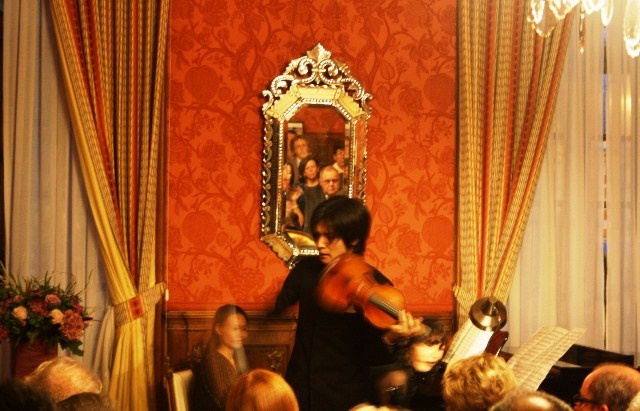
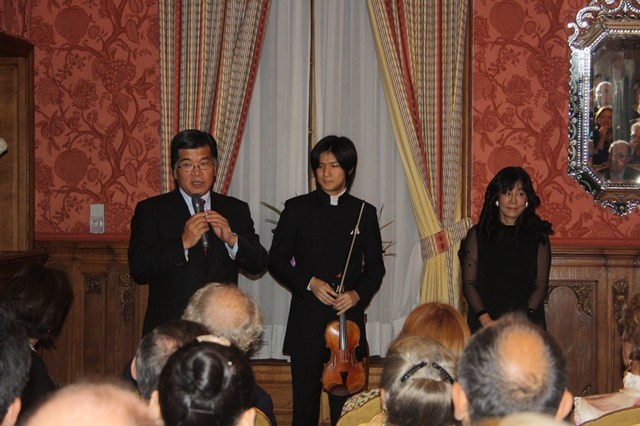 I think that it was enjoyable to listen to the music in a different setting from a big venue. On the second occasion, 3 days ago, a premiere of Chopin’s violin music in a musical score arranged by the Belgian Mr. Eugene Ysaye (1858-1931) was held. This score was found by the pianist Ms Ikuyo Nagata in the Unites States and was performed by the violinist Tatsuki Narita (accompanied by Ms Nagata herself) who was second at the Queen Elisabeth International Music Competition of Belgium last year (as this concert was reported on NHK news the following day, people in Japan could see part of it). Eugene Ysaye, being a musician who was instrumental to the creation of the Queen Elisabeth International Music Competition, I invited Belgian music lovers, people involved in the Queen Elisabeth International Music Competition and Mr. Ysaye’s descendants. I am glad that Belgium and Japan are connected through classical musi I think that it was enjoyable to listen to the music in a different setting from a big venue. On the second occasion, 3 days ago, a premiere of Chopin’s violin music in a musical score arranged by the Belgian Mr. Eugene Ysaye (1858-1931) was held. This score was found by the pianist Ms Ikuyo Nagata in the Unites States and was performed by the violinist Tatsuki Narita (accompanied by Ms Nagata herself) who was second at the Queen Elisabeth International Music Competition of Belgium last year (as this concert was reported on NHK news the following day, people in Japan could see part of it). Eugene Ysaye, being a musician who was instrumental to the creation of the Queen Elisabeth International Music Competition, I invited Belgian music lovers, people involved in the Queen Elisabeth International Music Competition and Mr. Ysaye’s descendants. I am glad that Belgium and Japan are connected through classical musi
< A Japanese Movie and My Lecture at the University of Namur >
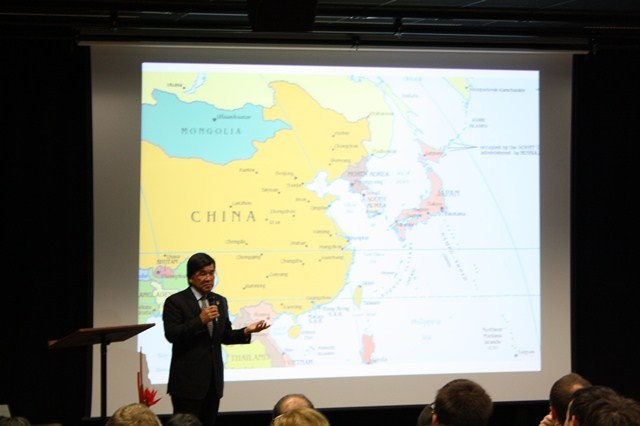 About two weeks ago, I gave a lecture of about an hour on the theme “From the Era of Samurai to Current Japan” at the University of Namur (65km southeast of Brussels). Before my lecture, the movie “After Flowers” (2010), based on the novel written by Mr. Shuhei Fujisawa and made into a movie by Mr. Kenji Nakanishi, was shown. After the showing, I talked about the modern history of Japan. I myself like Mr. Fujisawa’s historical novels and I watched most of their film adaptations. My favourite movies are “Twilight Seibei” and “Pride of Samurai” in particular. I hope that foreign fans of Japanese movies watch these works. The image of the poor life at the end of the Edo period in the Tohoku region (North-East of Japan) and the pride as a samurai to live rightfully is touching. It reminds us of the strict ethics that modern Japanese people have lost. When I was Consul General in Chicago in the United States, I showed “Twilight Seibei” to Americans, but their reaction was not so good. The quality of Fujisawa’s works might be difficult to understand without any knowledge about the historical background of the end of Edo and the local colour of the Tohoku region. In addition, for young Americans, a samurai movie without Ninjas and other Hollywood-like actions is not interesting. So, what about the Belgians? Well, the reactions were mixed, but I could see that it seemed difficult to understand. The philosophy of life and aesthetics of a samurai may be special... About two weeks ago, I gave a lecture of about an hour on the theme “From the Era of Samurai to Current Japan” at the University of Namur (65km southeast of Brussels). Before my lecture, the movie “After Flowers” (2010), based on the novel written by Mr. Shuhei Fujisawa and made into a movie by Mr. Kenji Nakanishi, was shown. After the showing, I talked about the modern history of Japan. I myself like Mr. Fujisawa’s historical novels and I watched most of their film adaptations. My favourite movies are “Twilight Seibei” and “Pride of Samurai” in particular. I hope that foreign fans of Japanese movies watch these works. The image of the poor life at the end of the Edo period in the Tohoku region (North-East of Japan) and the pride as a samurai to live rightfully is touching. It reminds us of the strict ethics that modern Japanese people have lost. When I was Consul General in Chicago in the United States, I showed “Twilight Seibei” to Americans, but their reaction was not so good. The quality of Fujisawa’s works might be difficult to understand without any knowledge about the historical background of the end of Edo and the local colour of the Tohoku region. In addition, for young Americans, a samurai movie without Ninjas and other Hollywood-like actions is not interesting. So, what about the Belgians? Well, the reactions were mixed, but I could see that it seemed difficult to understand. The philosophy of life and aesthetics of a samurai may be special...
< Signal Gun of the Brussels EKIDEN >
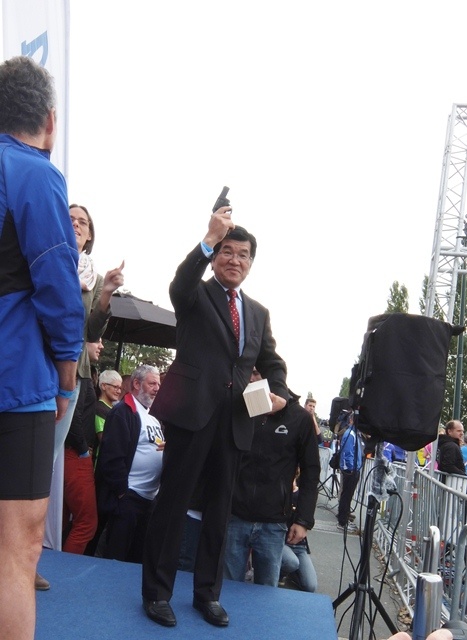 End of last week, I was invited to the amateur EKIDEN Brussels as a special guest and I fired the gun to signal the start together with Ms Tia Hellebaut, the Olympic gold medallist of Belgium (Beijing Olympics Women’s’ high jump in 2008). This event is organized by the Belgian company called “Acerta”. It is one of the biggest EKIDEN events in the world with 1260 teams and 7560 runners. Each team consists of 6 people and each runner runs a determined distance, covering 42.195 km in total. Members of the Embassy of Japan also formed one team with members of institutions related to the Japanese government in Brussels. Mr. Philippe Depaepe, general-manager of the organizing company, and I got acquainted by chance. I was pleased to hear from him, who runs a consultancy business for company management and employee training, that the “EKIDEN born in Japan is the best sport to strengthen the ties among employees”. End of last week, I was invited to the amateur EKIDEN Brussels as a special guest and I fired the gun to signal the start together with Ms Tia Hellebaut, the Olympic gold medallist of Belgium (Beijing Olympics Women’s’ high jump in 2008). This event is organized by the Belgian company called “Acerta”. It is one of the biggest EKIDEN events in the world with 1260 teams and 7560 runners. Each team consists of 6 people and each runner runs a determined distance, covering 42.195 km in total. Members of the Embassy of Japan also formed one team with members of institutions related to the Japanese government in Brussels. Mr. Philippe Depaepe, general-manager of the organizing company, and I got acquainted by chance. I was pleased to hear from him, who runs a consultancy business for company management and employee training, that the “EKIDEN born in Japan is the best sport to strengthen the ties among employees”.
< Jose Van Dam in the Saint-Michel Cathedral >
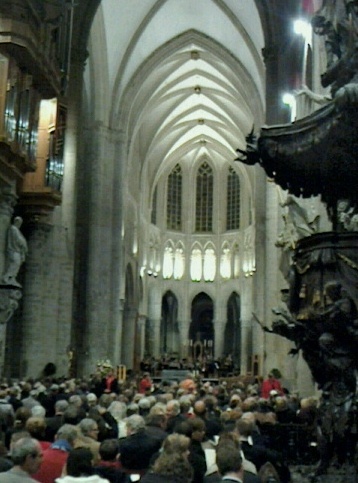 About 10 days ago, a beldonor concert was held in the Saint-Michel Cathedral in the centre of Brussels and I listened for the first time since my arrival in Belgium to the international opera singer Jose Van Dam singing live. Although he is 73 now, the charm of the bass-bariton singer’s low tone was still as strong as ever. This concert was a charity concert for organ donation, hosted by the Belgian government (Ministry of Health). The orchestra was composed by young musicians called the “Ensemble Orchestral de Bruxelles”. One male and one female opera singer sang alternately more than 10 songs. The male opera singer was, of course, Mr. Jose Van Dam and the female opera singer was, to my great surprise, a Japanese mezzo-soprano, called Miyagi Osada. Ms. Osada lives in Belgium and has been active mainly in Europe for the past 20 years, but I did not know her until that day. As she has the opportunity to co-star with Jose Van Dam a lot, opera fans know her very well. According to her CV, she is also a teacher of vocal music at a music school in Brussels. Speaking of Japanese female opera singers living in Brussels, I know Ms Yuko Masaki who teaches at the Conservatoire in Brussels, but there seem to be other female Japanese active in the opera world such as Ms Tomoko Taguchi, etc. In the case of Japanese, women might be more international than men. About 10 days ago, a beldonor concert was held in the Saint-Michel Cathedral in the centre of Brussels and I listened for the first time since my arrival in Belgium to the international opera singer Jose Van Dam singing live. Although he is 73 now, the charm of the bass-bariton singer’s low tone was still as strong as ever. This concert was a charity concert for organ donation, hosted by the Belgian government (Ministry of Health). The orchestra was composed by young musicians called the “Ensemble Orchestral de Bruxelles”. One male and one female opera singer sang alternately more than 10 songs. The male opera singer was, of course, Mr. Jose Van Dam and the female opera singer was, to my great surprise, a Japanese mezzo-soprano, called Miyagi Osada. Ms. Osada lives in Belgium and has been active mainly in Europe for the past 20 years, but I did not know her until that day. As she has the opportunity to co-star with Jose Van Dam a lot, opera fans know her very well. According to her CV, she is also a teacher of vocal music at a music school in Brussels. Speaking of Japanese female opera singers living in Brussels, I know Ms Yuko Masaki who teaches at the Conservatoire in Brussels, but there seem to be other female Japanese active in the opera world such as Ms Tomoko Taguchi, etc. In the case of Japanese, women might be more international than men.
|